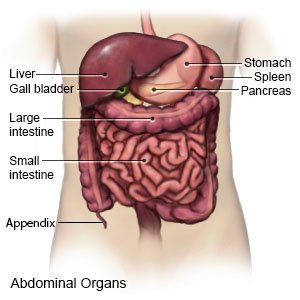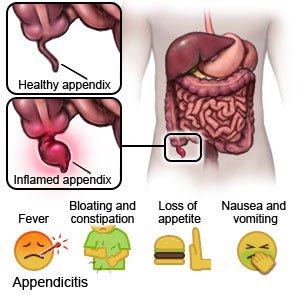Appendicitis in Adolescents
Medically reviewed by Drugs.com. Last updated on Apr 6, 2025.
What is appendicitis?
Appendicitis is inflammation of your appendix. The appendix is a small pouch in the lower right side of your abdomen. It is attached to the first part of the large intestine. The appendix may get blocked or infected and become inflamed. Inflammation may cause your appendix to swell, fill with pus and, burst. You will need immediate care to prevent a ruptured appendix. A ruptured appendix can cause bacteria to flow into your abdomen. This can lead to a serious infection called peritonitis.
 |
What are the signs and symptoms of appendicitis?
It is important to tell a parent or other adult if you develop certain symptoms. Symptoms may start suddenly and get worse quickly. The most common symptom is pain that starts at the belly button and moves to the lower right side of the abdomen. The pain worsens when you touch your abdomen, move, sneeze, cough, or take a deep breath. You may also have any of the following:
- Abdominal swelling
- Abdomen that feels hard or tender
- Diarrhea or constipation
- Loss of appetite
- Nausea or vomiting
- Fever
 |
How is appendicitis diagnosed?
Your healthcare provider will examine you and check for pain or tenderness in your abdomen. Tell your provider about all your symptoms. You may also need any of the following:
- Blood tests may be used to check for signs of infection or inflammation.
- CT, ultrasound, or MRI pictures of your abdomen may be used to check your appendix. You may be given contrast liquid to help your appendix show up better in the pictures. Tell the healthcare provider if you have ever had an allergic reaction to contrast liquid. Ask your parents if you are not sure. Do not enter the MRI room with anything metal. Metal can cause serious injury. Tell the healthcare provider if you have any metal in or on your body.
- A fluid culture test may be used if your appendix bursts. Your provider may take a fluid sample from your abdomen during a drainage procedure or appendectomy. This test will show which bacteria is causing the infection.
Drugs used to treat this and similar conditions
Zosyn
Zosyn is used to treat bacterial infections such as urinary tract and skin infections and ...
Piperacillin/tazobactam
Piperacillin/tazobactam systemic is used for appendectomy, appendicitis, aspiration pneumonia ...
How is appendicitis treated?
- Medicines may be given to prevent or treat an infection, or to manage pain.
- Drainage may be needed if you develop an abscess after a burst appendix. To drain the abscess, your healthcare provider guides a tube through your skin and into the abscess. Infected fluid drains through a tube.
- An appendectomy is surgery to remove your appendix. Your appendix may be removed through small incisions in your abdomen. If your appendix has burst, you may need an open appendectomy. A single, larger incision is made to remove the appendix and clean out the abdomen.
Treatment options
The following list of medications are related to or used in the treatment of this condition.
When should I seek immediate care?
- You have abdominal pain that gets worse or does not go away, even after you take medicine.
- You have a fast heartbeat or feel weak, or faint.
- You have trouble thinking clearly.
- You are vomiting and cannot keep food down.
When should I call my doctor?
- You have a fever or shaking chills.
- You have trouble having a bowel movement, or you have diarrhea.
- You have questions or concerns about your condition or care.
Care Agreement
You have the right to help plan your care. Learn about your health condition and how it may be treated. Discuss treatment options with your healthcare providers to decide what care you want to receive. You always have the right to refuse treatment. The above information is an educational aid only. It is not intended as medical advice for individual conditions or treatments. Talk to your doctor, nurse or pharmacist before following any medical regimen to see if it is safe and effective for you.© Copyright Merative 2025 Information is for End User's use only and may not be sold, redistributed or otherwise used for commercial purposes.
Learn more about Appendicitis
Treatment options
Care guides
Symptoms and treatments
Further information
Always consult your healthcare provider to ensure the information displayed on this page applies to your personal circumstances.
